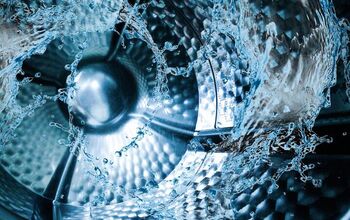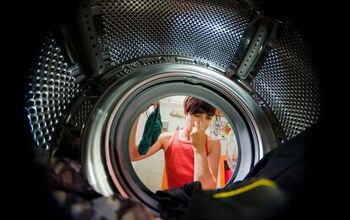Why Does My Washing Machine Keep Stopping? (Find Out Now!)

So, you started your washing machine and walked away to do other tasks. When you returned, instead of finding freshly cleaned laundry, you found half-washed, soapy clothing. This means your washing machine stopped mid-cycle. So, why does this happen?
There are many potential reasons why a washing machine might stop during a wash cycle. The potential problems could range from an imbalanced load of laundry to a damaged part. Luckily, it often means that the washer is detecting a problem and preventing further damage to the machine. This safeguard will save you time and money on more complicated repairs.
Keep reading for a breakdown of common problems that might cause a washing machine to stop mid-cycle, and how to fix them.
Do You Need Appliance Repair Services?
Get free, zero-commitment quotes from pro contractors near you.

Common Causes and Solutions
Figuring out why your washing machine keeps stopping might require some trial and error, as there are many potential culprits. Below, we’ve broken down some of the most common problems that can occur. You might even be able to fix some of them on your own!
Load Imbalance
This is a common problem in top-loading washing machines that occurs when all of the items have been loaded to one side, or have moved to one side during the cycle. It is also common when washing bulky items, such as bedding or towels. If you noticed a loud banging noise prior to your washing machine turning off, this is likely the culprit.
Many washing machines contain sensors that will detect imbalance and automatically turn off your machine to prevent damage to the machine itself. This is the simplest cause of a washer that keeps stopping, with the quickest fix:
- Pause the wash cycle.
- Open the lid.
- Redistribute the items evenly around the tub.
- Close the lid to resume the cycle.
If your washing machine constantly gets off-balance, there may be another problem at hand, This could include debris stuck behind the tub or a damaged part that needs to be replaced.
Power Supply
Another simple and straightforward reason why your washing machine stopped running is due to an issue with the power supply. This could mean that the lights flickered while your washing machine was running, or there might’ve simply been a random malfunction.
To fix problems with the power supply, try doing a master reset on your washing machine. This can be completed by simply unplugging the machine for one minute, and then plugging it back in. Some washers can also be reset by opening and closing the door 6 times in a row within 12 seconds.
Another potential problem with the power supply could be a faulty plug, which will require repair or replacement.
Door Lock or Lid Switch Malfunction
Every washing machine, no matter the type, has a mechanism on the door which either prevents the door from being opened mid-cycle or pauses the cycle when the lid or door is opened.
Top-loading washing machines contain a lid switch, which automatically pauses the cycle. This is operated by a pin on the bottom of the lid, which flips the switch when the lid is closed. Ensure that your lid is completely closed and that the pin has clicked. If this is the case and the washer still won’t resume the cycle, you may need to replace the lid switch.
Front-loading washing machines contain a door lock, to prevent users from opening the door mid-cycle. This is also present in some newer models of top-loading machines. This component can malfunction just like the lid switch. If your washer contains a digital screen, it might also display an error code when a malfunction has occurred with the door lock.
While it is possible for experienced individuals to replace the door lock and lid switch, it is best to consult a professional repair technician to avoid further damage.
Clogged Filter
Your washing machine contains a filter that catches debris and miscellaneous items. This feature prevents items from clogging or damaging the main drain, which can be a more serious problem. To avoid damage to your machine, it might shut itself down when the filter becomes clogged.
The filter is often located on the front of the washing machine in the bottom right corner. It can be identified by a small rectangular square, which is a panel that covers the filter components.
Here’s how to unclog your washing machine filter:
- Unplug your washing machine.
- Remove the rectangular cover. You may need to carefully pry it off with a tool such as a flathead screwdriver.
- Place a cup beneath the filter to catch any water or debris that may fall out.
- Remove the cap or plug and allow the excess water to drain out.
- Clear any debris inside that is causing the filter to be clogged.
- Put the filter back into place, and plug in your washing machine.
- Run a test cycle to determine whether this helped your machine run properly once again.
Residue Buildup
Your laundry detergent might leave behind residue that will build up in your washing machine’s drain hose. This will prevent your machine from operating properly. Luckily, this is a problem that only requires some cleaning, rather than a part replacement.
Here’s how to clear a clogged drain hose:
- Unplug your washer
- Move the washer away from the wall and remove the back panel to locate the hose.
- Place a bucket beneath the hose.
- Disconnect one end of the hose and allow any water to drain out.
- Disconnect the other end of the hose.
- Pour ¼ cup of baking soda into the tube.
- Pour vinegar into the tube.
- Rinse the hose with hot water.
- Reattach the hose and back panel, and plug in your washing machine.
Washing Machine Timer
Some washing machines contain a timer that signals the next cycle. If your timer is malfunctioning, it can cause the same cycle to be repeated over and over, or it can cause your washer to pause between cycles. Washing machine timers have been known to go bad over time.
To access the timer, you’ll either need to remove the back of your washer or the control board. Consult the manual for your washing machine model to identify the timer’s exact location, as it varies between models. You will need to test the timer with a multimeter to diagnose a problem. If a problem is identified, this part will need to be replaced.
Control Board
The control board is responsible for sending the correct signals to the components of your washing machine. When your control board begins to show signs of wear, it can send incorrect signals and lead to errors. To diagnose problems with your control board, search for visible signs of corrosion or damage or test it with a multimeter.
More Serious Potential Causes
If none of the solutions listed above get your washer back in working order, there may be a more serious problem. It might be a good idea to consult a repair technician for these problems, especially if you aren’t familiar with washing machine components. These are likely going to be more expensive repairs that require replacing parts.
Here are the parts that might be having problems:
- Faulty Water Pump or Motor. This will prevent water from being added or drained in the tub, which will prevent the sensors from signaling the next cycle.
Worn Drive Belt. This can also be diagnosed by a whining sound while your washer is running.
- Worn Direct Drive Motor Coupling
- Clutch Assembly. Some other signs of a malfunction with this part are a loud noise or burning smell while your washer is running.
Related Questions
There are a number of reasons why a washing machine might go off balance. You might have overloaded the tub, or it could simply be a result of bulky items within a load of laundry. It could also be a result of debris stuck between the tub and agitator. Or, your washing machine might not be on a level surface. If your washing machine is brand new, you might have accidentally missed a piece of packaging material to be removed.
If none of these problems is the culprit, your washing machine might have a damaged component that needs to be replaced. Contact a repair technician for best results.
Why Does My Washing Machine Get Residue Buildup?Residue buildup in your washing machine is a normal occurrence over time. If it seems to be happening too frequently, you might be using too much soap per load, leaving excess soap behind. If this is the case, you might also notice excess soap left behind on your clothing.
To prevent residue buildup, run your washer’s clean cycle regularly. Alternatively, clean your washing machine by running an empty cycle with 2-4 cups of white vinegar.
Do You Need Appliance Repair Services?
Get free, zero-commitment quotes from pro contractors near you.

Conclusion
There are a number of reasons why a washing machine might stop mid-cycle. These potential reasons range from simple to complex. Some can be easily fixed at home, and others will require assistance from a technician.
When diagnosing the problem with your washer, start by trying out the simple fixes, unless there are other signs indicating a bigger problem with your machine. Then work your way to the more complicated potential problems until you get your machine back in working order.

Dakotah Forbes is a copywriter and content writer specializing in home decor and design. She is dedicated to helping readers find answers to all their home design questions by creating helpful guides and articles. In her spare time, she loves to use her creative spirit to complete her own home decor and DIY projects. Dakotah graduated from James Madison University with a BA in Media Arts and Design and currently resides in Virginia with her husband.
More by Dakotah Forbes



























